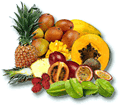
March 2006
The Daley News
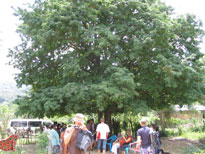 We have had an exciting start to the year with a flush of rain to the Northern Rivers region. So much so, we are once again feeling Kyogle's title as gateway to the rainforest is justified. In news futher afield, Greg has just returned from a Oxfam Challenge ride through Sri Lanka, with fantastic stories to tell and a heap of wonderful pictures of Sri Lankan flora and fauna. During his travels by bicycle, he captured the Tamarind Tree , monkeys, elephants and mountains on film. The visit to an Oxfam Project in Northern Sri Lanka was Greg's highlight. He found it inspiring to see a project where donated funds were going a long way to help communities develop
We have had an exciting start to the year with a flush of rain to the Northern Rivers region. So much so, we are once again feeling Kyogle's title as gateway to the rainforest is justified. In news futher afield, Greg has just returned from a Oxfam Challenge ride through Sri Lanka, with fantastic stories to tell and a heap of wonderful pictures of Sri Lankan flora and fauna. During his travels by bicycle, he captured the Tamarind Tree , monkeys, elephants and mountains on film. The visit to an Oxfam Project in Northern Sri Lanka was Greg's highlight. He found it inspiring to see a project where donated funds were going a long way to help communities develop 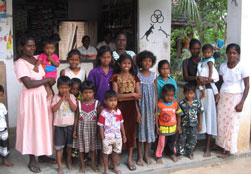 sustainable livelihoods. Especially considering the poor living conditions and erosion of basic human rights the civil war had caused. While there, he noticed that a key aspect of the work in Sri Lanka was focused on peace building and conflict resolution. The Oxfam program aims to reconcile Sinhalese and Tamil communities, so they can understand each other and work together. If any one with an adventurous spirit wants to do something to alleviate these problems while having an experience of a lifetime, Greg suggests that you take a look at the Oxfam Challenges
sustainable livelihoods. Especially considering the poor living conditions and erosion of basic human rights the civil war had caused. While there, he noticed that a key aspect of the work in Sri Lanka was focused on peace building and conflict resolution. The Oxfam program aims to reconcile Sinhalese and Tamil communities, so they can understand each other and work together. If any one with an adventurous spirit wants to do something to alleviate these problems while having an experience of a lifetime, Greg suggests that you take a look at the Oxfam Challenges
Now back to the orchard, we have been relishing the longans, which are coming off in the orchard. They are as good, if not better than a lychee, with a sweet flavour and juicy texture. But we have to be quick to beat the fruit bats and Rod to taste any of them for ourselves. The guavas are cropping and we are coming up with lots of ideas for the  Hawaiian Supreme guava as it has the most beautiful pink flesh and is very tasty fresh, juiced or used in fruit salads. There is a heavy crop on the governors plum but they are not quite ready, so we shall be munching on these in the weeks to come, along with the feijoas. I am hoping that my fruit fly baiting will reduce the numbers of stung fruit on the feijoa trees, as the fruit flies also love them.
Hawaiian Supreme guava as it has the most beautiful pink flesh and is very tasty fresh, juiced or used in fruit salads. There is a heavy crop on the governors plum but they are not quite ready, so we shall be munching on these in the weeks to come, along with the feijoas. I am hoping that my fruit fly baiting will reduce the numbers of stung fruit on the feijoa trees, as the fruit flies also love them.
We are experimenting with technology on our web site once again and have placed a 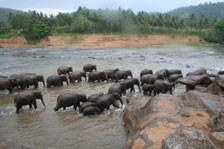 short video on-line of our mail order packing technique. The idea is to demonstrate how we pack your plants for delivery. This is at the front of our shop page on our web site click on Watch Videos – Packing Your Plants for an almost live demonstration. We are hoping to experiment with this form of technology more in future newsletters as we feel it conveys information in an exact manner. I would like to thank all our customers who have provided us with valuable feedback in the last few months as this is vital to us and helps us perform to the best of our ability. Happy gardening to you all.
short video on-line of our mail order packing technique. The idea is to demonstrate how we pack your plants for delivery. This is at the front of our shop page on our web site click on Watch Videos – Packing Your Plants for an almost live demonstration. We are hoping to experiment with this form of technology more in future newsletters as we feel it conveys information in an exact manner. I would like to thank all our customers who have provided us with valuable feedback in the last few months as this is vital to us and helps us perform to the best of our ability. Happy gardening to you all.
Velvet Apple – Diospyros discolor
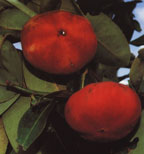 The velvet apple is native to the islands of the Philippines, where it is known as the Mabolo. It is a very attractive tree, closely related to ebony and persimmons, it takes a little of the character of each of its cousins as it has attractive useful timber and edible fruits that look a little like a persimmon. The tree will grow to around 8-10 meters in an Australian garden, although it can be seen as a 20m tree in its native habitat. As an evergreen tree, the velvet apple can be grown as an ornamental as it has extremely attractive foliage. The leaves are dark green and glossy on the upper surface, the underneath surface is covered in fine hairs, giving a silvery sheen to the backs of the leaves, the new growth is a stunning pale green or silver, and the habit of the branches is weeping.
The velvet apple is native to the islands of the Philippines, where it is known as the Mabolo. It is a very attractive tree, closely related to ebony and persimmons, it takes a little of the character of each of its cousins as it has attractive useful timber and edible fruits that look a little like a persimmon. The tree will grow to around 8-10 meters in an Australian garden, although it can be seen as a 20m tree in its native habitat. As an evergreen tree, the velvet apple can be grown as an ornamental as it has extremely attractive foliage. The leaves are dark green and glossy on the upper surface, the underneath surface is covered in fine hairs, giving a silvery sheen to the backs of the leaves, the new growth is a stunning pale green or silver, and the habit of the branches is weeping.
Trees are not fast growing but they are also not fussy about soil types making them easy to grow. They will flourish in most soils with little care but they do not tolerate cold conditions or salt-laden winds. They prefer a warm to hot sub tropical or tropical climate with protection from cold conditions.
Male flowers are borne on separate trees to the female flowers; so male trees need to be planted near to female trees for effective pollination and fruit set. The fruits vary in skin colour from pink, brownish, yellow, and orange to purple-red. When they are seedless they tend to be flattish in shape where as the fruits with seeds are more rounded or conical. Fruits are often borne in pairs on opposite side of the branches where they give out an off-putting aroma of fruity cheese. This aroma is in the velvety skin of the fruits and as the skin is tough and papery it is best removed before eating, this also removes the odor; peeled fruits are best eaten once they have chilled in the fridge for couple of hours.
The flesh of the velvet apple is creamy-white, soft and mealy with a sweetish flavour. It is moist but not juicy and suggests a banana-flavored apple. They can be seasoned with lime or lemon juice, diced fresh and used in either sweet or savory salads.
Tree Waratah – Alloxylon flammeum
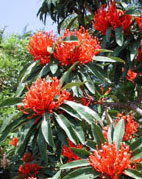 Native to the Atherton Tableland in North Queensland this tree is one of our most beautiful and alluring rainforest trees. Vibrant flowers are conspicuously held on the outside of the foliage. When in full flower, trees can been seen glowing deep red from a distance. The flowers contrast with the rich green glossy foliage with stunning effect and are seen on the trees in spring and early summer. It makes an ideal native specimen tree. For more info on Tree Waratah go to www.rbgsyd.nsw.gov.au/ mount_annan_botanic_gar...
Native to the Atherton Tableland in North Queensland this tree is one of our most beautiful and alluring rainforest trees. Vibrant flowers are conspicuously held on the outside of the foliage. When in full flower, trees can been seen glowing deep red from a distance. The flowers contrast with the rich green glossy foliage with stunning effect and are seen on the trees in spring and early summer. It makes an ideal native specimen tree. For more info on Tree Waratah go to www.rbgsyd.nsw.gov.au/ mount_annan_botanic_gar...
It was once seen as a large tree in its native tropical rainforest home but much of its habitat has been lost to clearing and with it has gone the tree waratahs, they are now listed as vulnerable. Known for their attractive pink timber, the Latin name refers to this, Alloxylon, allo meaning different or foreign, xylon meaning wood, referring to the wood grain, which is unusual yet similar to oak, flammeum means fiery red referring to the flowers.
In its natural setting the tree Waratah can reach heights of 20 m or more, but away from tall rainforest it is commonly seen as a medium sized tree to about 10m with a bushy crown. It grows well in cultivation and will flower as far south as Melbourne, however it dislikes frost and poorly drained heavy soils. If provided with extra moisture during dry periods, protection from strong winds and well-drained soils with a high degree of organic matter, the Tree Waratah will thrive. It can take about six years to flower but it is well worth the wait, the nectar rich blooms are highly attractive to birds and make extremely beautiful cut flowers.
Peanut Tree - Sterculia quadrifida
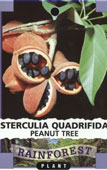 This tree is a great tree if only because its name makes me giggle. Sterculia comes from the Latin Sterculius who was the Roman god of dung-heaps and privies. This refers to the potent aroma of the flowers of most of the genus, the flowers of the peanut tree however are lemon-scented. They are small and inconspicuous compared with the huge eye catching and tasty fruits.
This tree is a great tree if only because its name makes me giggle. Sterculia comes from the Latin Sterculius who was the Roman god of dung-heaps and privies. This refers to the potent aroma of the flowers of most of the genus, the flowers of the peanut tree however are lemon-scented. They are small and inconspicuous compared with the huge eye catching and tasty fruits.
A native to drier rainforests of Eastern Australia, north from the Richmond River in Northern NSW, the peanut tree grows from 6m – 18m depending on conditions. In cooler climates, it will be deciduous for a period in winter and in other areas, it can be semi-deciduous. It is relatively hardy, however it does not tolerate frosts or poor drainage, if given ideal conditions it is fast growing, flowering and fruiting at a young age.
The pods of the peanut tree are its most striking feature, they are large red and beautiful. Shiny satin, blue-black seeds line the outer edges of the pods creating a fantastic contrast of colour. The seeds are edible raw or roasted and they taste similar to peanuts hence the common name. They are a little time consuming to peel but they are tasty and worth the effort, making a great addition to stir-fries or as a bush food snack. In the garden, the peanut tree has an attractive symmetrical and upright form. The pods can be used in cut flower arrangements although unfortunately they do not keep their spectacular colour for long.
If seeds are available, the peanut tree is a fantastic tree for kids to grow in the Christmas holidays. They germinate and grow very quickly making them ideal to inspire children in the garden. An excellent holiday project can see their peanut trees in the ground before school goes back.
Fruit Fly Baiting Program.
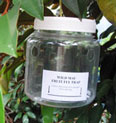 A quick update on my fruit fly baiting program. In the last newsletter, I introduced the organic fruit fly bait, Wild May, I have set traps in the orchard here at the nursery and I have a trap set in my home orchard, which is 10 km from Kyogle. In the orchard here, which covers an area of ½ a hectare and has 200 trees, I have collected only 34 flies in the first month of baiting. In my home orchard, which consists of only 25 young trees which are about to start cropping, I have collected 83 flies. It is interesting as the only trees at fruiting age in my orchard at this stage are the mulberry and the nectarine, this is the first fruit production done on this piece of land aside from the native bush, which could possibly be the reason for the high numbers of flies.
A quick update on my fruit fly baiting program. In the last newsletter, I introduced the organic fruit fly bait, Wild May, I have set traps in the orchard here at the nursery and I have a trap set in my home orchard, which is 10 km from Kyogle. In the orchard here, which covers an area of ½ a hectare and has 200 trees, I have collected only 34 flies in the first month of baiting. In my home orchard, which consists of only 25 young trees which are about to start cropping, I have collected 83 flies. It is interesting as the only trees at fruiting age in my orchard at this stage are the mulberry and the nectarine, this is the first fruit production done on this piece of land aside from the native bush, which could possibly be the reason for the high numbers of flies.





